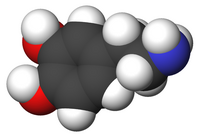
Photo from wikipedia
Abstract Introduction Tardive dyskinesia (TD) is a persistent and potentially disabling movement disorder associated with dopamine receptor blocking agents (eg, antipsychotics). Valbenazine is a highly selective vesicular monoamine transporter 2… Click to show full abstract
Abstract Introduction Tardive dyskinesia (TD) is a persistent and potentially disabling movement disorder associated with dopamine receptor blocking agents (eg, antipsychotics). Valbenazine is a highly selective vesicular monoamine transporter 2 inhibitor with several safe and effective dosing options now approved for once-daily (QD) treatment of TD in adults. Valbenazine 80 mg QD is the recommended dose for TD; however, 40 or 60 mg QD (newly approved dose) may be considered depending on response and tolerability. The recent approval of valbenazine 60 mg was based on results from an analysis that used the FDA’s model-informed drug development (MIDD) approach and leveraged existing data from the 6-week, phase 3 registration trial of valbenazine (KINECT 3). Methods A population pharmacokinetic (popPK) model was developed to describe plasma concentration-time profiles for valbenazine and its primary active metabolite, [+]-α-dihydrotetrabenazine ([+]-α-HTBZ). An exposure-response (E-R) model was developed using the area under the concentration-time curve (AUC) of [+]-α-HTBZ (exposure) and change from baseline in the Abnormal Involuntary Movement Scale total score (AIMS-CFB) (response). Stepwise E-R model development evaluated various linear and nonlinear models to describe AIMS-CFB vs [+]-α-HTBZ AUC and time. E-R relationships established with the 40 and 80 mg data were used to predict AIMS-CFB for a 60 mg dose up to week 6, accounting for study-to-study, inter-individual, and residual variabilities. Results Steady-state valbenazine and [+]-α-HTBZ concentrations were well described by a joint parent-metabolite popPK model. An Emax model with asymptotic exponential delay in the maximal valbenazine effect adequately characterized the E-R relationship between AIMS-CFB and [+]-α-HTBZ AUC. The simulated confidence intervals of response were consistent with the observed KINECT 3 results, demonstrating the utility of the model to predict efficacy results. The established E-R model was subsequently used to predict AIMS-CFB for valbenazine 60 mg QD at week 6. Mean AIMS scores decreased (improved) in a dose-dependent manner, with 60 mg QD predicted to result in least-squares mean (SEM) AIMS-CFB of −2.7 0.4, which is between the reported AIMS-CFB for 40 mg (−1.9 ± 0.4) and 80 mg (−3.2 ± 0.4). All simulated trials demonstrated valbenazine 60 mg to be significantly superior to placebo in AIMS-CFB after 6 weeks of treatment. Conclusions This analysis integrated and leveraged data from two previously approved valbenazine doses (40 and 80 mg QD) using an MIDD approach. The results provided key evidence that an intermediate dose (newly approved 60 mg QD) could be considered therapeutically beneficial without the need for an additional clinical trial. The availability of a valbenazine 60 mg dose to complement the previously approved doses fills an existing medical need for patients with TD who could benefit from this third effective dose. Funding Neurocrine Biosciences, Inc.
Journal Title: CNS Spectrums
Year Published: 2022
Link to full text (if available)
Share on Social Media: Sign Up to like & get
recommendations!